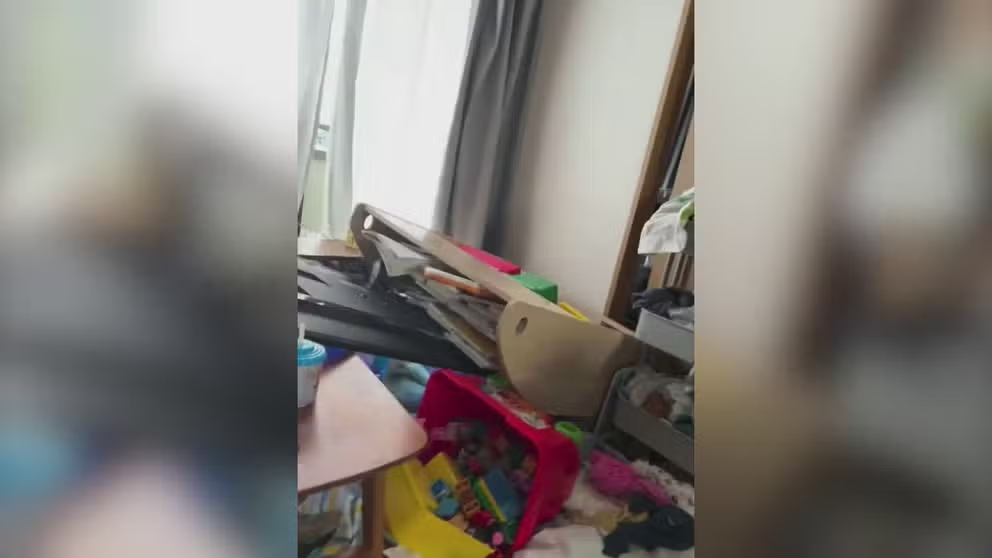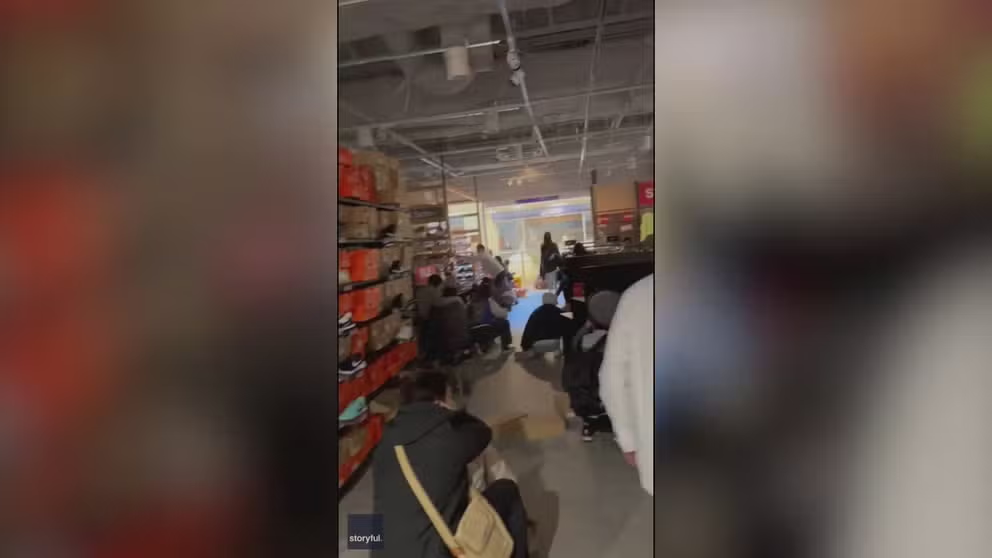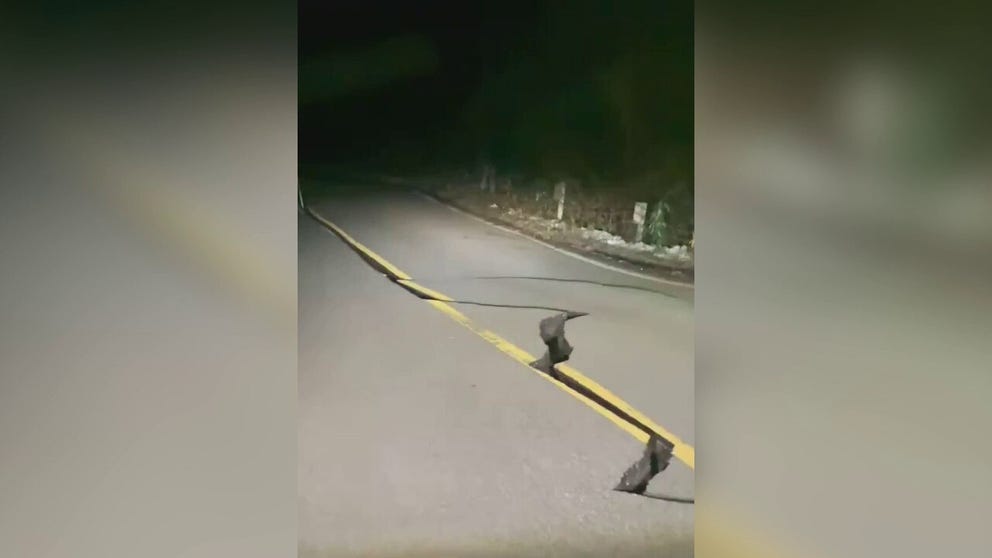What to do during and after an earthquake
Washington’s Department of Emergency Management and the state's Dept. of Health have compiled several steps you should take to stay safe during a quake, no matter what part of the country you're in.
Powerful earthquake rocks train station in central Japan
Structural damage was reported in central Japan on Monday after a magnitude 7.5 earthquake hit the region.
Suddenly, the ground begins shaking and swaying, and you realize you’re in the middle of an earthquake. What should you do?
The best advice to survive a strong quake depends on where you are and what you’re doing when the ground begins to shake.
The coastal Pacific Northwest and California have several active faults, as do Alaska and Hawaii, but earthquakes have occurred in several parts of the U.S. east of the Rockies.
EAST VS. WEST: WHY EARTHQUAKES ARE FELT DIFFERENTLY ON EITHER SIDE OF THE US
Washington’s Department of Emergency Management has compiled several steps you should take to stay safe during a quake, no matter what part of the country you're in.
What to do if an earthquake happens while you’re inside
The key to remaining safe during a quake if you're inside are three simple steps: drop, cover and hold on.
"That means DROP to the ground or lower your center of gravity, take COVER under a sturdy desk or table and COVER your neck and head with one arm, and HOLD ON to your cover with the other arm until the shaking stops," says Hollie Stark, Outreach Program Manager at the Washington Emergency Management Division. If your desk or table moves, move with it and stay there until the quake is over.
WHAT TO PUT IN AN EMERGENCY SUPPLY KIT
Officials say don’t rush outside during a quake. While you may worry you are at risk of being caught inside a collapsing building, you may run into a more dangerous situation from falling objects outside of buildings.
Child cries as power of Japanese earthquake felt in family home
The power of the earthquake that hit Japan on Monday was dramatically demonstrated in a family home in Kanazawa, near to the epicenter in Ishikawa prefecture.
"Our building codes (in the U.S.) are strict enough now that we don't have to worry about buildings collapsing or ‘pancaking’ in the event of an earthquake," Stark told FOX Weather. "A person's likeliest risk of injury from an earthquake in the U.S. is from either stepping on something while trying to evacuate during the shaking (like broken glass, furniture, etc.) or something falling off the outside of the building (like bricks or other external features), which is why ‘drop, cover and hold on’ is the recommended protective action here in the U.S."
THESE ARE THE WORLD'S MOST POWERFUL EARTHQUAKES ON RECORD
In years past, standard advice had been to get into a door frame, but that advice has since changed with more research.
"We do not recommend people get into a door frame for myriad reasons," Stark said. "Doors will swing and could injure fingers; debris will be thrown from multiple directions that a door frame cannot stop, and door frames are rarely load-bearing and unlikely to offer as much protection as a sturdy piece of furniture, to name a few."
Meanwhile, avoid being near objects that could present a danger from falling or breaking, such as windows, bookcases, refrigerators, heavy mirrors or hanging plants.
RUINS FROM JAPAN'S DEADLY EARTHQUAKE AS SEEN FROM SPACE
If inside a theater or stadium, stay in your seat and protect your head with your arms or get under the seat if possible.
If inside a crowded store or public place like a mall, don’t rush for the exit. Instead, "drop, cover and hold" in a place away from display shelves that contain heavy objects.
Shoppers huddle together as magnitude 7.5 earthquake shakes mall in Japan
Shoppers huddled together as a store shook in Oyabe, Japan, on Monday, after a magnitude 7.5 earthquake hit the Ishikawa prefecture.
If you’re outside during an earthquake
Make sure to move away from any trees, signs, buildings or electrical wires and poles.
If you’re in an urban area, such as along a sidewalk, duck inside a building’s doorway or lobby to protect against any falling bricks, glass or other debris that may jar loose from building exteriors.
What to do if you're driving during an earthquake
If caught in your car when the Earth starts shaking, slowly pull over to the side of the road and stop, taking care to avoid stopping on or under overpasses and bridges, power lines or any other hazards that could topple onto your vehicle.
WHAT ARE THE TYPES OF FAULTS AND HOW DO THEY RELATE TO EARTHQUAKES?
Stay inside the vehicle until the shaking stops. Watch for any cracked or buckled roads when resuming driving. If in mountainous areas, be wary of rock or landslides.
What if I am in a wheelchair during an earthquake?
The Washington State Department of Health says if you are in a wheelchair when a quake strikes, stay in the chair and move to a safe cover.
"If possible, lock your wheels and cover your head with your hands," emergency managers said.
What should you do after an earthquake?
First, check yourself and those around you for injuries. If you smell gas or hear a hissing sound, open a window and leave the building, emergency managers said. Be sure to shut off the main gas valve outside.
Watch for any downed power lines, and be careful when entering any buildings. The Washington Emergency Management Division says to avoid unnecessary driving and stay off the phone unless needed for an emergency.
If the quake was large, and you live right along the coast, you could face an additional risk of tsunamis.
RESEARCHERS TAP AI TECHNOLOGY FOR DEVELOPMENT OF TSUNAMI WARNING SYSTEM
"If you are on the coast, once the shaking has stopped, get to high ground immediately as a tsunami could be coming," says Elyssa Tappero, Tsunami Program Manager at the Washington Emergency Management Division.
Large cracks appear on Japan highway after earthquake
Large cracks appeared on roads in central Japan on Monday after a magnitude 7.5 earthquake hit the region.
Also, be prepared for aftershocks, which can trigger additional damage, especially to any objects left vulnerable by the original quake.
It is also a good idea ahead of time to establish emergency contacts who live outside your area. It will likely be easier for family members to reach a person outside the quake zone to check in than try to reach other family members in the quake zone directly.
Finally, if you live in California, Oregon or Washington, you can sign up for ShakeAlerts to your cell phone, which may provide a few seconds' warning of an impending quake, allowing you to seek a good place to take cover before the shaking begins.



